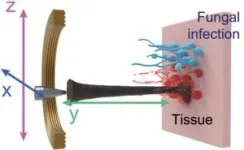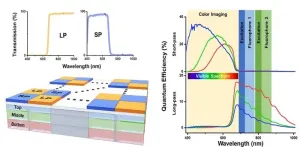(Press-News.org) Infections caused by fungi, such as Candida albicans, pose a significant global health risk due to their resistance to existing treatments, so much so that the World Health Organization has highlighted this as a priority issue.
Although nanomaterials show promise as antifungal agents, current iterations lack the potency and specificity needed for quick and targeted treatment, leading to prolonged treatment times and potential off-target effects and drug resistance.
Now, in a groundbreaking development with far-reaching implications for global health, a team of researchers jointly led by Hyun (Michel) Koo of the University of Pennsylvania School of Dental Medicine and Edward Steager of Penn’s School of Engineering and Applied Science has created a microrobotic system capable of rapid, targeted elimination of fungal pathogens.
“Candidae forms tenacious biofilm infections that are particularly hard to treat,” Koo says. “Current antifungal therapies lack the potency and specificity required to quickly and effectively eliminate these pathogens, so this collaboration draws from our clinical knowledge and combines Ed’s team and their robotic expertise to offer a new approach.”
The team of researchers is a part of Penn Dental’s Center for Innovation & Precision Dentistry, an initiative that leverages engineering and computational approaches to uncover new knowledge for disease mitigation and advance oral and craniofacial health care innovation.
For this paper, published in Advanced Materials, the researchers capitalized on recent advancements in catalytic nanoparticles, known as nanozymes, and they built miniature robotic systems that could accurately target and quickly destroy fungal cells. They achieved this by using electromagnetic fields to control the shape and movements of these nanozyme microrobots with great precision.
“The methods we use to control the nanoparticles in this study are magnetic, which allows us to direct them to the exact infection location,” Steager says. “We use iron oxide nanoparticles, which have another important property, namely that they’re catalytic.”
Steager’s team developed the motion, velocity, and formations of nanozymes, which resulted in enhanced catalytic activity, much like the enzyme peroxidase, which helps break down hydrogen peroxide into water and oxygen. This directly allows the generation of high amounts of reactive oxygen species (ROS), compounds that have proven biofilm-destroying properties, at the site of infection.
However, the truly pioneering element of these nanozyme assemblies was an unexpected discovery: their strong binding affinity to fungal cells. This feature enables a localized accumulation of nanozymes precisely where the fungi reside and, consequently, targeted ROS generation.
“Our nanozyme assemblies show an incredible attraction to fungal cells, particularly when compared to human cells,” Steager says. “This specific binding interaction paves the way for a potent and concentrated antifungal effect without affecting other uninfected areas.”
Coupled with the nanozyme’s inherent maneuverability, this results in a potent antifungal effect, demonstrating the rapid eradication of fungal cells within an unprecedented 10-minute window.
Looking forward, the team sees the potential of this unique nanozyme-based robotics approach, as they incorporate new methods to automate control and delivery of nanozymes. The promise it holds for antifungal therapy is just the beginning. Its precise targeting, rapid action suggest potential for treating other types of stubborn infections.
“We’ve uncovered a powerful tool in the fight against pathogenic fungal infections,” Koo says. “What we have achieved here is a significant leap forward, but it’s also just the first step. The magnetic and catalytic properties combined with unexpected binding specificity to fungi open exciting opportunities for an automated ‘target-bind-and-kill’ antifungal mechanism. We are eager to delve deeper and unlock its full potential.”
This robotics approach opens up a new frontier in the fight against fungal infections and marks a pivotal point in antifungal therapy. With a new tool in their arsenal, medical and dental professionals are closer than ever to effectively combating these difficult pathogens.
Hyun (Michel) Koo is a professor in the Department of Orthodontics and in the divisions of Pediatric Dentistry and Community Oral Health and is the co-founder of the Center for Innovation & Precision Dentistry in the School of Dental Medicine at the University of Pennsylvania.
Edward Steager is a research investigator in the School of Engineering and Applied Science’s General Robotics, Automation, Sensing & Perception Laboratory at Penn.
Other authors include Min Jun Oh, Alaa Babeer, Yuan Liu, Zhi Ren, Zhenting Xiang, Yilan Miao, and Chider Chen of Penn Dental; and David P. Cormode and Seokyoung Yoon of the Perelman School of Medicine.
This research was supported in part by the National Institute for Dental and Craniofacial Research (R01 DE025848, R56 DE029985, R90DE031532 and; the Basic Science Research Program through the National Research Foundation of Korea of the Ministry of Education (NRF-2021R1A6A3A03044553).
END
Nanorobotic system presents new options for targeting fungal infections
Researchers from Penn Dental and Penn Engineering have developed a new way to rapidly and precisely eradicate fungal infections in the mouth by using nanorobots guided by magnets
2023-05-26
ELSE PRESS RELEASES FROM THIS DATE:
Bird brains can flick switch to perceive Earth’s magnetic field
2023-05-26
Earth’s magnetic field, generated by the flow of molten iron in the planet’s inner core, extends out into space and protects us from cosmic radiation emitted by the Sun. It is also, remarkably, used by animals like salmon, sea turtles and migratory birds for navigation.
But how? And why? A new study from researchers at Western’s Advanced Facility for Avian Research (AFAR), home to the world’s first hypobaric climatic wind tunnel for bird flight, explores a brain region called cluster N that migratory birds use to perceive Earth’s magnetic field. The team discovered the region is activated very ...
Food for thought: UH study highlights the role of clean technology in reducing food waste
2023-05-26
Foodservice companies have long struggled with the challenge of what to do with all of their food waste. But researchers at the University of Houston Conrad N. Hilton College of Global Hospitality Leadership are shedding light on how clean technology can help those companies reduce waste and establish long-term sustainability goals.
In a study published in the Journal of Hospitality & Tourism Research, Tiffany S. Legendre, an associate professor at Hilton College, and her team, interviewed 17 leaders of the country’s largest on-site foodservice providers (e.g., Aramark, Compass and Sodexo), ...
Illinois Tech announced as enrollment partner in NIH’s AI precision nutrition research, largest project of its kind
2023-05-26
CHICAGO—May 26, 2023—Illinois Institute of Technology is one of 14 institutions chosen as an enrollment site for the National Institute of Health’s landmark initiative to advance nutrition research. Nutrition for Precision Health (NPH), powered by the All of Us Research Program, is working to engage 10,000 participants from diverse backgrounds across the United States with the aim of learning about how our bodies respond differently to food.
NPH will use artificial intelligence–based ...
World leader in photonics gives talk at Aston University
2023-05-26
Talk by one of the leading lights in optical communications
Dr. Ming-Jun Li is currently a corporate fellow at Corning Incorporated
He discussed installed optical fibres for ultra-wideband transmission systems.
26 May 2023 | Birmingham, UK
Aston University has hosted one of the leading lights in optical communications and speciality optical fibres at its second international photonics workshop.
Dr. Ming-Jun Li is currently a corporate fellow at Corning Incorporated in the USA and headed ...
GPS tracking reveals how a female baboon stopped using urban space after giving birth
2023-05-26
A new study from Swansea University and the University of Cape Town provides the first documented evidence of a cessation in urban space use by a female baboon after giving birth: another example of how wild animals are adaptively responding to urbanisation.
The study, recently published in the journal Ecology & Evolution, used GPS collars to track the movements of 13 chacma baboons in Cape Town, South Africa.
The data revealed that when one collared female gave birth, she stopped using urban space without any significant change in daily distance travelled or social interactions that would be expected with general risk-sensitive behaviour during this ...
Tree islands bring biodiversity to oil palm plantations
2023-05-26
Islands of trees in oil palm plantations can significantly increase biodiversity within five years without reducing productivity. This has been shown by an experiment, which has been running for over ten years in Indonesia as part of the Collaborative Research Centre (CRC) "EFForTS" at the University of Göttingen. An international team of researchers led by Göttingen planted experimental islands of trees in plantations on the island of Sumatra to counteract the species loss caused by the ...
Innovative endoscopic imaging system can detect multiple fluorescent tracers
2023-05-26
For patients with solid cancers, endoscopic surgery is one of the primary treatment options to remove tumors. However, there is a high risk of cancer recurrence if even a small number of cancerous cells are left behind after surgical resection. To prevent this from happening, researchers developed fluorescence-guided surgery (FGS). In FGS, patients are injected with a fluorescent probe that preferentially binds to tumor cells, enabling surgeons to easily identify lesions with the help of specialized endoscopes that emit the necessary excitation light.
Unfortunately, tumors can be highly heterogeneous, ...
CHOP researchers show that IgA fine tunes the body’s interactions with microbes
2023-05-26
Philadelphia, May 26, 2023—IgA deficiency is the most common primary immune deficiency worldwide, but its presentation has puzzled physcians and researchers. Some with the disorder present with symptoms like recurrent infections, autoimmune disease, or allergies, whereas others have no symptoms at all and only become aware of their IgA-deficient status through an incidental finding on a blood test. This variability has raised the question among researchers: Why aren’t many of those with IgA deficiency sicker?
A new study by researchers at Children’s ...
Protein-based nano-‘computer’ evolves in ability to influence cell behavior
2023-05-26
HERSHEY, Pa. — The first protein-based nano-computing agent that functions as a circuit has been created by Penn State researchers. The milestone puts them one step closer to developing next-generation cell-based therapies to treat diseases like diabetes and cancer.
Traditional synthetic biology approaches for cell-based therapies, such as ones that destroy cancer cells or encourage tissue regeneration after injury, rely on the expression or suppression of proteins that produce a desired action within a cell. This approach can take time (for proteins ...
Gene therapy rescues hearing for the first time in aged mouse models
2023-05-26
By 2050, one in 10 individuals are expected to live with some form of hearing loss. Of the hundreds of millions of cases of hearing loss affecting individuals worldwide, genetic hearing loss is often the most difficult to treat. While hearing aids and cochlear implants offer limited relief, no available treatment can reverse or prevent this group of genetic conditions, prompting scientists to evaluate gene therapies for alternative solutions.
One of the most promising tools used in these therapies—adeno associated virus (AAV) vectors—has galvanized the hearing-loss community in recent years. ...
LAST 30 PRESS RELEASES:
Making lighter work of calculating fluid and heat flow
Normalizing blood sugar can halve heart attack risk
Lowering blood sugar cuts heart attack risk in people with prediabetes
Study links genetic variants to risk of blinding eye disease in premature infants
Non-opioid ‘pain sponge’ therapy halts cartilage degeneration and relieves chronic pain
AI can pick up cultural values by mimicking how kids learn
China’s ecological redlines offer fast track to 30 x 30 global conservation goal
Invisible indoor threats: emerging household contaminants and their growing risks to human health
Adding antibody treatment to chemo boosts outcomes for children with rare cancer
Germline pathogenic variants among women without a history of breast cancer
Tanning beds triple melanoma risk, potentially causing broad DNA damage
Unique bond identified as key to viral infection speed
Indoor tanning makes youthful skin much older on a genetic level
Mouse model sheds new light on the causes and potential solutions to human GI problems linked to muscular dystrophy
The Journal of Nuclear Medicine ahead-of-print tip sheet: December 12, 2025
Smarter tools for peering into the microscopic world
Applications open for funding to conduct research in the Kinsey Institute archives
Global measure underestimates the severity of food insecurity
Child survivors of critical illness are missing out on timely follow up care
Risk-based vs annual breast cancer screening / the WISDOM randomized clinical trial
University of Toronto launches Electric Vehicle Innovation Ontario to accelerate advanced EV technologies and build Canada’s innovation advantage
Early relapse predicts poor outcomes in aggressive blood cancer
American College of Lifestyle Medicine applauds two CMS models aligned with lifestyle medicine practice and reimbursement
Clinical trial finds cannabis use not a barrier to quitting nicotine vaping
Supplemental nutrition assistance program policies and food insecurity
Switching immune cells to “night mode” could limit damage after a heart attack, study suggests
URI-based Global RIghts Project report spotlights continued troubling trends in worldwide inhumane treatment
Neutrophils are less aggressive at night, explaining why nighttime heart attacks cause less damage than daytime events
Menopausal hormone therapy may not pose breast cancer risk for women with BRCA mutations
Mobile health tool may improve quality of life for adolescent and young adult breast cancer survivors
[Press-News.org] Nanorobotic system presents new options for targeting fungal infectionsResearchers from Penn Dental and Penn Engineering have developed a new way to rapidly and precisely eradicate fungal infections in the mouth by using nanorobots guided by magnets







